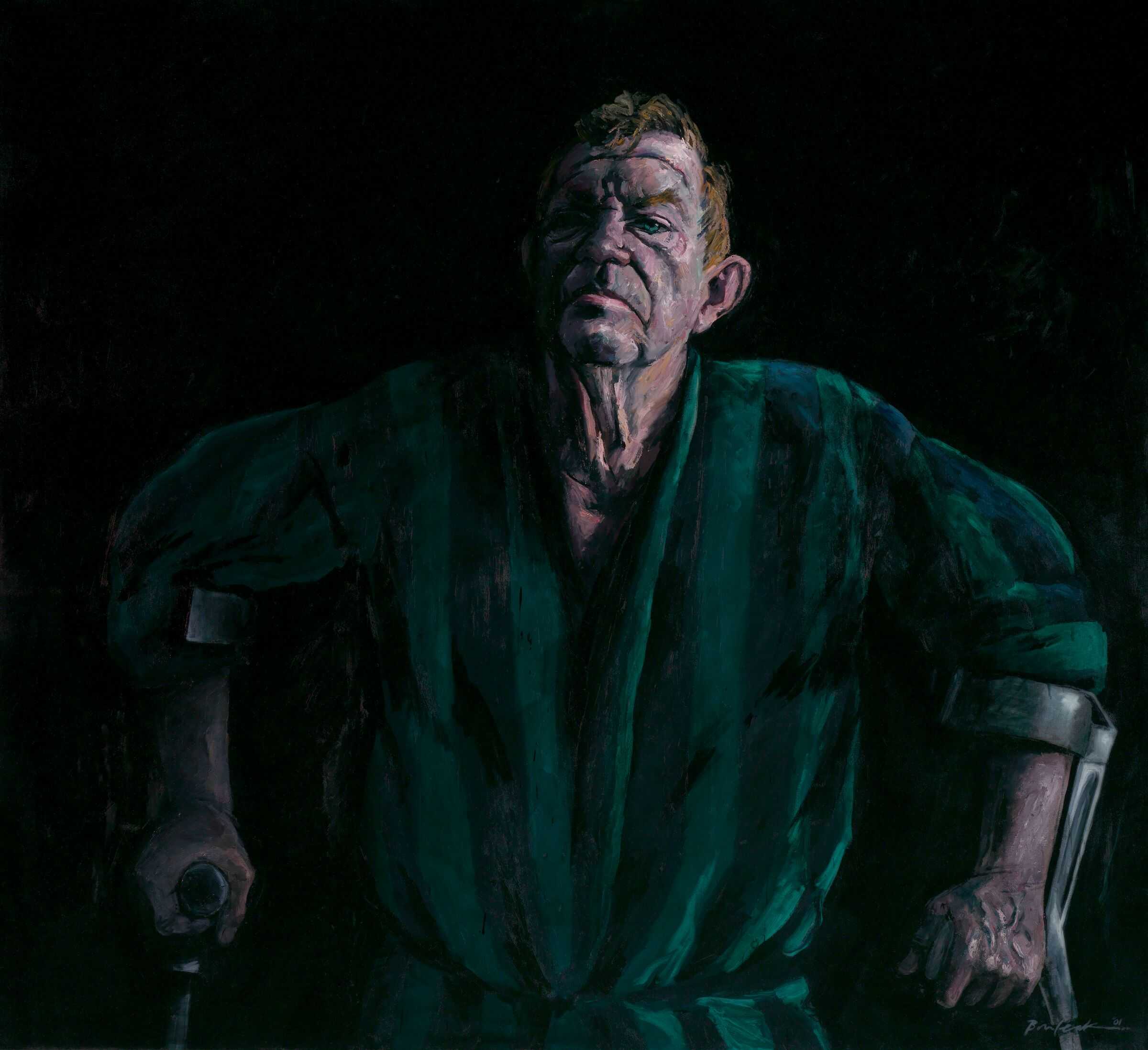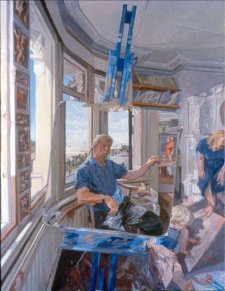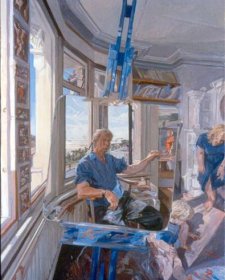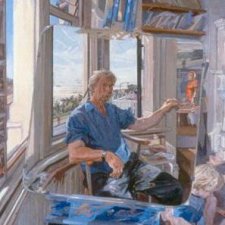The National Portrait Gallery has several portraits by you and we have just acquired your painting of Robert Hughes. It is a massive canvas, and it is very dark. Could you tell us about how you came to paint a portrait of Hughes so soon after his car accident, and also something of the idea behind the portrait?
All right. Well, I had always admired Bob Hughes, because I always read all his work and I think he is probably one of the best art writers in the world. The first time I ever met him was at an Australian Republican Movement dinner. I was encouraged by my then wife to go up and talk to him, and pt it to him that I should do a portrait of him. But I didn’t want to do it because I don’t know him. I went up and introduced myself and he said, ‘I hope you are not going to ask me if I will sit for a portrait because the answer is definitely no… I’m asked at least a couple of times a week to sit for portraits, and it’s the last thing I want to do.’ I said, ‘Right, okay,’ and I felt like a complete fool.
A couple of years later I was invited to a dinner and Bob was there. On this particular occasion he said, ‘I want to talk to you, Leak.’ He always call me Leak. And he said, ‘Come with me, Leak. We have to have a talk.’ So we went out and sat on the patio and he said, ‘Well, I’m nearly 60 years of age now and I have a face.’ I said, ‘There’s no doubt about it, Bob, you’ve got a face.’ And he said ‘I think it’s about time that someone painted my face, and I think it should be you.’ So I was very happy and I said, ‘Well, let’s do it.’ And he said that the next time he was in Sydney he would get onto it.
So this was before the car accident?
Yes, years before. Anyway, we stayed in touch… [When] he was in Australia to work on the series Beyond the Fatal Shore he told me that he wanted me involved in it, and we also discussed doing the portrait. He said, ‘Well, I’m going to be here for quite a while so we’ll be able to work on the portrait as well.’ So it was all sort of set in concrete that I was going to do the portrait while he was in Australia doing that series, and he also asked me to participate in it too. And a couple of days later he had his accident, up near Broome…
When Bob was physically able to just get around, he went around doing voice-overs and doing pieces to camera for the series. I saw quite a lot of him at that time, and we organised a few sittings and got started on the painting. And there was even one sitting that was filmed as part of that show. That was kind of nerve-racking.
So it was a real sitting?
It was a real sitting, but it was so difficult to do because all this other stuff was happening. When I work on a portrait, it’s hard enough just to have that one person in the room. Sometimes I have two people in the room; I like that. I like having someone else there to do like an interview with the person that I’m painting. That leaves me free to just work on the painting and I don’t have to concentrate on all the talking and all that other stuff that goes on.
And there were about three sittings altogether for the preliminary canvas?
That's about it, yes. And then I hadn't finished it and Bob had to go back to New York, and there was all the terrible business about his court case and all the rest of it. So off he went and I was stuck here with a three-quarters finished portrait that I didn't like.
One thing that me and Bob really connect on is the subject of Goya, because Goya is my favourite painter and probably my favourite person, out of history or whatever. I just love him. And Bob is probably the leading expert on Goya in the world.
My old man was very sick - this must have been January last year, so it would have been about 18 months ago. I went with my two sons to Adelaide to visit my father. We stayed there for a while, and I was kind of upset because my father was ill. (He died soon after that.) But I was driving back to Sydney with the children and we stopped at Narrandera for the night. We were in a motel and I couldn't sleep because I was thinking about this bloody portrait. I thought, 'I really want to finish this thing, but I don't know how to do it.' I dozed off, and I woke up about 20 minutes later and I had this idea. I just thought, 'Christ, what I've got to do is a black painting.'
As a cartoonist and as a caricaturist I use black all the time, and I love the way that the Spanish painters - Velasquez, Goya, Picasso - all use black so beautifully. I'd always been very timid of using black in my paintings. I thought about what he's been through and what he's coming out of, and I thought, 'It's black. It's just a black period of his life.' And it related to our mutual admiration of Goya, and I thought, 'Well, I'll use that as the inspirational point.' I had this idea that I had to just exaggerate the drawing of it, because in that study that you've seen the real pain and the real defiance of the bloke is not coming through. That's one of the things that I really admire about Bob.
So those characteristics were something you wanted to communicate in the portrait?
Yes. I thought, 'I really want this to come out. I want him as I know him to be in the portrait.' And when I looked at that study I just thought it wasn't there, that strength, that real fighter quality that he's got. He really is a tenacious bastard, and he's bloody tough. I mean, he's physically tough to have survived the ordeal in the first place; he's intellectually tough, because he thinks for himself. His opinions come from his head. He's a very original thinker, and he's a wonderful analyst of art. So there I was in Narrandera at about 2.30 in the morning with this brilliant flash of inspiration. I could see the painting in my head and that what really counts. It's a little bit like doing cartoons. You know there's an idea there somewhere, and as soon as you see it in your head, then you're away. I saw this painting in my head and I thought, 'I've got to have him emerging out of the blackness'.
I'm interested in the scale, because the painting is huge. Do you generally work on a large scale?
On big formats? No, not always. I like to work on a large scale, though.
You obviously consciously decided to make it larger than life.
Well, slightly larger than life. Bob is a big bloke, but he's big in terms of his own authority. He is one of those blokes who fills up a room. Do you know what I mean? So a little mousy painting of Bob wouldn't have been appropriate for what I wanted to say about him. I wanted the thing landscape format so you could see the way that he was always walking round on these sticks, and the pain that he was going through. I mean, it's physically bloody demanding, walking round like that on those sticks, anyway, and when your whole body has been shattered and you've got broken bones all over you...
Has he seen a photograph or image of the final portrait?
He has seen photographs of it.
What was his response?
Well, he looks at it but he doesn't say much, which is good. Judging by his reaction I think it works really well. I think he looks at it and just thinks that it's painful for him to look at. That's the impression that I get, anyway. I haven't sat down and asked him for a critique.











